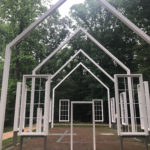
By BJC Executive Director Amanda Tyler

This summer, I had an enriching opportunity to learn and deepen my connection to our Baptist history. I participated in the Baptist Theological Seminary at Richmond’s course and immersion experience, “A Shelter for Conscience: Religious Liberty among Baptists and other Dissenters,” which included visits to historic religious liberty sites in Virginia. The group’s tour included a stop at the BJC’s Center for Religious Liberty on Capitol Hill in Washington, D.C., where I was a guest lecturer.
Starting in Richmond, we toured historic churches that connect the present to the past. We saw Sixth Mount Zion Baptist Church, founded by Pastor John Jasper, a celebrated preacher who began his ministry as an enslaved person. We visited St. John’s Episcopal Church, where Patrick Henry delivered his famous “give me liberty or give me death” speech. We went directly from the Liberty Trail to the Richmond Slave Trail and Lumpkin’s Jail, referred to as “the Devil’s Half Acre” by enslaved Africans held for auction there.
We learned how dangerous it was to be a Baptist in Virginia in the 18th century, when you would have almost certainly known at least one person who had been jailed or whipped for preaching without a license. Baptists often discuss this history, but the trip left me asking questions, too. How much more dangerous was it to be a black person of any religion during that time? How do we reconcile the birth of religious liberty in a place that denied liberty to nearly half the population? How do we appropriately celebrate the achievements of Jefferson and Madison without idealizing them to the point of turning a blind eye to their sins of action and inaction? Once raised, these questions are not easily answered. Addressing them in an honest and forthright way, I believe, is essential to a more complete and inclusive treatment of religious liberty going forward.
We also toured notable historical sites, including Polegreen Church, which marked the preaching ministry of Presbyterian Samuel Davies. An open-air, modern frame in stark white outlines the footprint of a meeting house destroyed in the Civil War (pictured on this page). It was there that we learned, from Virginia Baptist Historical Society Director Nathan Taylor, about the ways that Presbyterians dissented within the system, applying for preaching permits, while our Separate Baptist forebears resisted the licensure process itself as an affront to soul freedom. Then, as now, there are various ways to resist authoritarian control. We needed all approaches for disestablishment of official religion in Virginia and the other colonies.
The Polegreen site (pictured right) also included a walking timeline of religious liberty, with stone markers beginning in the Roman Empire and continuing through 18th century Virginia. As I silently walked through the centuries of oppression, I wondered how exceptional are these times in which we are living now? Are the challenges we face truly greater than those that earlier Americans or citizens of the world confronted? Despite hyperbolic pronouncements around us, I think the answer is no. But what helped those before us overcome injustices were their exceptional responses to their times. I believe that we are in need of extraordinary witnesses for justice, mercy and humility to confront our present-day challenges to religious freedom for all.
The walking timeline ends in 1791 with the adoption of the First Amendment and its guarantee that “Congress shall make no law respecting an establishment of religion, or prohibiting the free exercise thereof.” Our Founders left us with a first freedom that has, at times, been more aspirational than descriptive. It is up to us, as both heirs and sustainers of that freedom, to make those words a reality, not just for ourselves but for people of all races and ethnicities, and of all faiths and of no faith at all.
This article appeared in the July/August 2018 edition of Report from the Capital. You can also read the digital version of the magazine or view it as a PDF.




